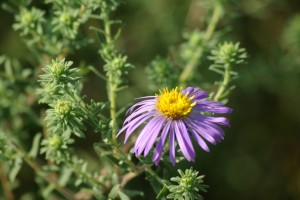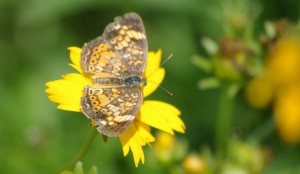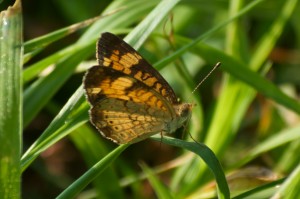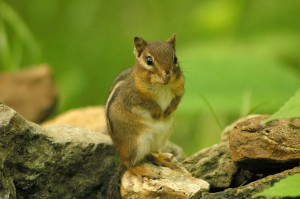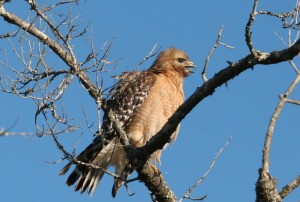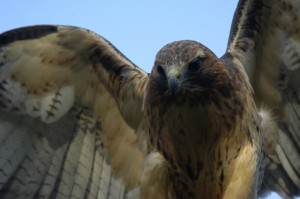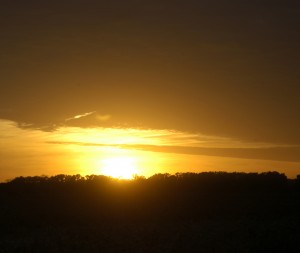Asters Give Bluff Scape a Final Splash of Color While Hawks Soar Overhead
When our bluff’s grasslands, woodland edges, and cropfields have all but given up for the season in September and are turning to burned-out colors, along come asters, giving the bluff scape a final splash of whites, purples, and blues before winter sets in.
There are 120 species of asters in North America; 38 in Illinois; and 17 in Monroe and Randolph Counties. All share a unique flower structure. The yellow centers are composed of hundreds of tiny fertile florets, called disk flowers. The petals, which display whitish to violet, to blue, to purplish hues, depending on the species, really are sterile appendages, called ray flowers.
Of our 17 species of asters, about a half dozen have whitish ray flowers while the remainder show shades of blues and lavender-purple. Asters grow in a myriad of places: open fields and woods, hill prairies and glades.
Hairy aster (A. pilosus) is by far the most common in our bluffs. A bushy plant up to four feet tall, with needle-like leaves, and lots of half-inch wide white flowers, it grows abundantly in old fields and roadsides.
Local Native Americans brewed a tea for headaches from the leaves of hairy aster. White-tailed deer adore the plant, eating the basal leaves in spring and stems and flowers in late summer and fall. Many songbirds, especially sparrows, relish the seeds.
Our bluff lands also host the rather unique blue wood, or heart-leaved, aster (A. cordifolius). It is found only deep in the woods along the Mississippi and Illinois Rivers’ bluffs, from southern Illinois northward into Minnesota. Smooth-stemed, with distinctive heart-shaped leaves, these asters bloom into October, sporting one-half inch wide pale blue-violet ray flowers and yellow disk flowers which turn reddish in time.
Blue wood asters offered a variety of uses to the earliest bluff inhabitants. Local Amerindians used it as a fumigant, burning dried leaves over fires to ward off evil spirits. Early European settlers, seeking a similar release from poor spirits, smoked the dried leaves in pipes as a calming agent, or “nervine.” But among the Chippewa, who lived in Wisconsin, Minnesota and Canada, the leaves were smoked in pipes to attract deer for hunting. Although no longer used as a medicinal, perhaps blue wood asters worked as the Chippewa believed, for Wisconsin now hosts 4.5 million white tails, compared to only 1.5 million in Illinois.
All of our native asters are important food plants for Pearl Crescents, our most common and abundant butterfly. The yellowish, brown mottled, one-inch wing-spanned butterflies love to congregate on moist sites, forming “puddle clubs” which can number in the dozens. They raise three generations (broods) in the bluff lands each year, from April through October.
Pearl Crescent females lay their eggs only on asters, which serve as the sole
food source for the caterpillar larvae. The third brood’s larvae over winter on asters and metamorphose into butterflies early the next spring.
Another big fan of asters is our Eastern Chipmunks. The darling little dashers are curious — often entering yards in search of food — but shy — scurrying off as soon as they sense they have been detected. They have rusty fur coats with black and white stripes beginning on their cheeks and running down the sides. The head and body is five to six inches long, and the tail adds another three to four inches of length to the four-ounce Eastern Chipmunk. Chipmunks seem to be eager communicators. Their high-pitched “cuck-cuck” calls, which can be mistaken for frog calls, often go on, nonstop, for a half-hour. The long conversations seem to take place between mothers and juveniles, since, except for mating, adult chipmunks live solitary lives. They breed in April and again in late summer and, by September, the second brood of chipmunks will be off foraging and denning on their own.
They are primarily ground dwellers and live in intricately constructed, architecturally sophisticated underground dens. Along a tunnel system, which can be up to 30 feet in length, they build living rooms, bed rooms, storage rooms, and, at the lowest and deepest level, a toilet room. They primarily eat seeds, but also will forage for bulbs, fruits, nuts, and even meat and eggs. Notorious hoarders — up to a half bushel of nuts and seeds have been found in chipmunk dens — they transport all their groceries in their expandable cheek pouches. In the fall, asters, and their abundant seed crops, make a favorite food shopping stop. But the chipmunk, busily stuffing its cheeks with aster seeds, can itself become a meal, as resident and migratory hawks search out food.
Broad-winged Hawks, one of the most common breeding hawks in the Eastern U.S. and Canada, often migrate in large flocks. Called “kettles,” these large flocks can number into the thousands, since nearly all fall migration occurs within a compressed time period from mid-August, in the far north, through mid-October. The peak migration period across the eastern U.S. is in the mid to third week of September. The single-day record for the most number of migrants in the eastern U.S. was the spectacular count of more than 550,000 Broad-winged Hawks in Wayne County Michigan on September 17, 1999.
Most broad-wings take fairly direct flight paths on a heading to the Texas Gulf Coast, then continue flying along the Gulf of Mexico through Mexico and Central America and into South America to their wintering grounds. Small numbers of broad-wings travel south through Florida and into the Florida Keys but then re-migrate a short distance back north and winter in Southern Florida. Their aversion to migration across the Gulf — unlike many far smaller birds, such as hummingbirds which cross the Gulf twice each year — is the result of the hawks’ energy-saving flight strategy of relying on land-created thermal heat updrafts which allow them to soar and glide, instead of actively wing-flapping.
Our bluff lands, with large, unfragmented blocks of mature woodlands, interspersed with occasional glades, sinkhole ponds and creeks, provide near-perfect nesting territories for Broad-winged Hawks. They are secretive during the mating and nesting season but can sometimes be spotted during the spring as they court high in the sky. Then the birds circle high on thermals and sometimes engage in sky-dancing — a series of closed-wing dives followed by sharp upturns and sometimes a full roll-over in the air. Once mated, the pair spends 30 to 38 days incubating their two to three eggs, with the male taking over duties when the female hunts for her own meals. After 35 to 42 days in the nest the young birds begin to perch on nearby branches, then take their first flights. The fledglings continue to get close parental supervision and feeding for three to four more weeks and are largely independent after another month. Broad-winged Hawks, and their offspring, often return to the same breeding areas each year.
Broad-winged Hawks feed primarily on small mammals, birds, and amphibians, but will also take reptiles and large insects. Hunting is done from a perch and nearly all prey is taken on the ground. Broad-wings are among the smallest of the members of the genus Buteo and average 16 inches in length with a wingspan of just under one yard. When seen perched, a broad-wing shows largely brown colors on the head, back and wings. Viewed from below, an adult broad-wing shows whitish underwings bordered by black outer feathers; some birds show a great deal of pale chestnut streaking on their bodies, and a rare form, called a “dark morph,” has a uniformly dark brown body. The underside of the tail shows broad black and white bands.
Several other buteo species also grace the skies over our bluff lands. Perhaps the most familiar and, indeed, the most common buteo of North America, is the Red-tailed Hawk. Our resident Red-tailed Hawk population will expand during
the fall and winter as birds that bred as far north as Hudson Bay in Canada migrate to our area and further south. Our population of Red-shouldered Hawks will be similarly enlarged by migratory birds which summered and bred as far north as Canada’s Maritime Provinces. And, by early winter, a few Rough-legged Hawks may migrate in, although our area is about as far south in the Eastern U.S. as these birds travel after leaving their breeding areas in Northernmost Canada and Alaska.
As the hawks begin to migrate out of and through our area, many songbirds also begin preparations for their journey south to wintering grounds. Unlike the hawks, most songbirds travel at night and so, before both spring and fall migrations, their regular sleep patterns begin to change. Ornithologists describe the nocturnal restlessness that songbirds display as “Zugunruhe” — a German word roughly translated as “course unrest.” Captive songbirds from migratory populations undergo this restless fitfulness even when caged. During nighttime observations, these birds were observed hopping and changing perches and then perching for extended times only while facing the correct direction for migration. Birds with the longest migration paths showed
the greatest restless movements. But, perhaps, the “course unrest” of migratory songbirds is akin to the human restlessness we describe as “spring fever.” Even though we are not regular migrants, the seasons — and their steady cycles of change — can still call us outdoors, searching, waiting and watching.
That restlessness can create its own reward in our bluff lands — a view of asters splashing final bright colors over our landscape, as hawks soar overhead, metaphorically winging us with them on their journey south away from the approaching winter.
Clifftop, a local nonprofit organization, is focused on preserving and protecting area bluff lands.
A version of this article appeared in the September 5 2007 edition of the Monroe County Clarion.
© 2007 all content rights reserved, Clifftop NFP.
Comments are currently closed.

